Edible Mushrooms: a forager’s guide to the fungi of Britain, Ireland and Europe covers about 450 edible and toxic fungi recorded as present in the British Isles and the temperate zones of Europe. Detailed information and high quality photographs are provided on well over 300 of the most important edible, toxic and very common species, plus a few that are of interest for other reasons. The most comprehensive competing books currently in print cover fewer than 100 species. The book is published by Bloomsbury and is available from regular book retailers.
Signed copies (with personalised messages if requested) are available directly from me for £24.99 (RRP), free P&P. Postage is second class, and price only applies to the UK. If you want me to send a copy internationally then please email me for a postage quote.
Signed copy of paperback £24.99 (incl P&P)
British fungi foraging: from mycophobia to mycomania
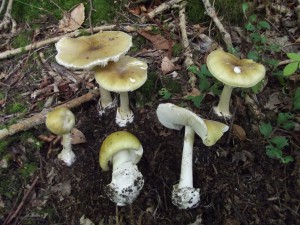
Not so long ago the only wild fungus that the British even thought about picking was the humble field mushroom, and most people were so scared of eating something dangerous that they wouldn’t even touch those. It wasn’t always like that. I have a book published in 1941 – “Wild Foods Of Britain” by Jason Hill – that features another five. But even if we reached a particularly low ebb in the late 20th century, the people of these islands have always been rather mycophobic compared to the majority of other European nations. We can only guess at the reasons for this. One theory is that the druids were the only class of people allowed knowledge of fungi in ancient Britain, and everybody else was taught to fear them. It is certainly the case that we’ve historically associated “toadstools” with witches, bats, spiders and…toads. The word “toadstool” has no meaning beyond “like a mushroom, but you wouldn’t want to eat it” and is liable to be applied to any sort of mushroom that isn’t an Agaricus (the genus to which the field mushroom and cultivated mushroom belong). Whatever the reason for this historical mycophobia, we are currently in the midst of a dramatic cultural change of heart. Foraging, especially foraging for fungi, has never been more popular in Britain, and interest is rapidly growing.
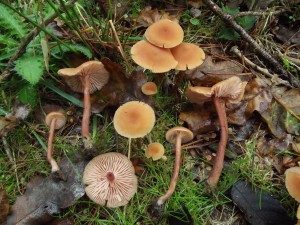
Why has this happened? Why now? There are two main reasons. The first is a widespread food revolution: no longer is Britain the land of fried breakfasts, fish and chips, roast beef and not much else. We now have a massive diversity of restaurants, serving food from all around the world. Pubs have become gastro-pubs. Cookery competitions dominate prime-time television. No surprise then that the foodies among us are taking a greater interest in the possibility of finding, fresh and for free, delicacies that cost a small fortune and are often only available dried – if you can buy them at all. The other strand is a broad cultural trend towards sustainability, self-sufficiency and a desire to reconnect with the landscape and the natural world. There is a sense that our civilisation is an out-of-control monster, heading towards catastrophe, both economic and ecological. And we’ve responded with a desire to re-learn ancient and forgotten skills, from growing our own food, to making essential items using pre-industrial technologies, knitting and mending old clothes, right back to knowing how to track animals and start fires without matches. Foraging for wild food fits very well into this cultural backdrop.
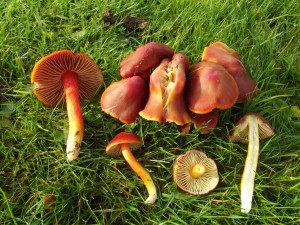
There’s still a lingering fear of eating the wrong fungus and ending up in hospital – or worse. This isn’t entirely a bad thing. In some European nations where gathering fungi has always been a national pastime, cases of poisoning caused by wild fungi are counted in their tens of thousands annually. Fear, leading to caution, can sometimes be a life-saver. Foraging for fungi can be done safely though. One just has to exercise a certain amount of common sense, and follow a few rules.
There’s another advantage to our mycophobic history: we come at this with no pre-existing ideas of what is edible and what isn’t. Most of my foraging students start off knowing absolutely nothing about fungi. Contrast that with the Russian family who hired me because they wanted to introduce their five-year-old daughter to foraging. All they actually wanted from me was to show them somewhere they could find some of the things they knew from back home. When I tried to teach them about other edible species – good ones – they said, “We don’t eat those in Russia.” “But you hired me to teach you about edible fungi, and I’m telling you those are good to eat!”, I said, but they were having none of it. Each country has its own idiosyncrasies – its own selection of things traditionally eaten and things traditionally rejected. Lacking any tradition (apart from rejecting almost everything), we in Britain have the chance to approach this topic with an open mind, and that can only be a good thing.
Sample pages (click for larger version):
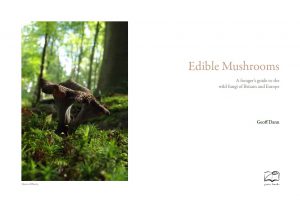
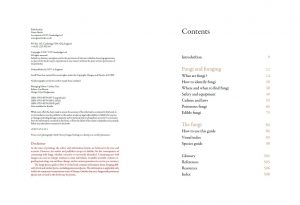
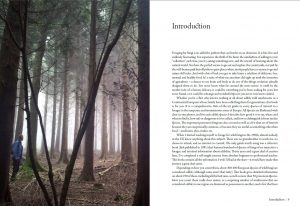
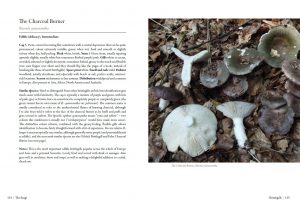

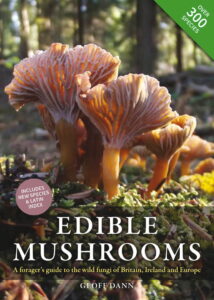
Great news that this book will be available soon. I have a lot of mushrooms growing around our property in Ashford, Kent and am looking for a substantial guide that is applicable to my area.
Please keep me posted on the launch.
Lee
Could you let me know when you book is published, as I’d really like a copy.
Many thanks
Manse
Hi Manse. It should be published around October/November next year.
Hi Geoff
Really looking forward to the publication of your book. It sounds like a must-have. I hold foraging & cookery courses in the Battle/Hastings area focusing on plants and have sent a few people your way specifically for fungi foraging. Looking forward to meeting you!
Sarah
Hi Sarah
Yes, I think I’ve come across your website before. I’ll do my best to make the book live up to expectations! Thanks for sending business my way and I’m sure we will run into each other at some point…
Geoff
Oops, only just seen this reply. I’d love to come on one of your courses. I guess the best thing is to book on one of your West Kent walks before they fill up? I can’t see anything more local to Hastings at the moment…
Hi Sarah. I don’t run any open-to-the-public courses in or around Hastings, no. Most of my work is private bookings. The only courses I currently run that people can book individual places on are the fungi sessions in Hemsted Forest. Geoff
Thanks Geoff, hope to meet you on one of those then 🙂
Hi Geoff
Will your book be field guide size?
I will buy it whatever the size, just curious.
Regards
Tony
Hi Tony
The book will be 234 mm x 168 mm portrait, so not really a field guide, no. I don’t yet know what the page count is going to be, but the manuscript is currently in excess of 80,000 words and there will be plenty of illustrations, so it is likely to be quite a big book.
Geoff
Hi Geoff,
Would love a copy of your book from you when you get your copies.
Cheers,
Phil Leng
Hi Phil
You’re on the list.
regards,
Geoff
Please can I order a signed book from you please, once it is available.
Many thanks
Hi George. Yes, of course. I will email you.
i am interested in buying the book direct from yourself, with or without signature, as i like the idea of the bulk of the cash going to the author not the retailer.
my email was wrong on the previous comment … contact me on the one listed for you in this comment
hi the discount code i have does not seem to work should it still be valid or not?
Hi Stephen
The discount offer/code expired on Sunday.
Geoff
Hi Geoff,
Came across your site trying to find a foraging course, with my interest in mushrooms ( since those liberty cap hunting days) reingaged after a woodland walk in Ireland. I have not tasted wild mushrooms since my childhood, ink caps and blewits mainly. My mother in her 80’s still passionately hunts, took me out, as she says this year has not been been good in the SE.
Keep be posted on the launch, looks like the book I need.
Anita
Hi Anita
The book launch was back in October. I still have signed copies of the book available though. Best to email me on geoffdann@hotmail.com if you’d like one. And no, not a great year for fungi in the south of England.
Geoff
I would like to purchase a signed copy of your book for my fiances Xmas gift how can I do that please
Email me on geoffdann@hotmail.com
Hi Geoff, it was an interesting observation about your Russian clients. I had to laugh. I am Russian and know exactly where they are coming from. Russians are picky mushrooms pickers 🙂 The reason is simple. With Russia’s vast forests there’s such an abundance of prized ceps, chantrelles and the likes that your mushroom baskets just won’t have space for anything else. My retired uncle that lives close to a forest goesh mushroom picking every day and brings bucketfuls of boletes. He doesn’t even bother with others, he only has 2 hands after all. When I moved to Ireland I was shocked that mushrooms were so scarce here. I was forced to go outside my comfort zone and discovered other tasty fungi. Otherwise there would be hardly any wild mushrooms on our plates. My uncle keeps me supplied with dried ceps though which vastly improve my family’s meals:)
Hi Elena
That bit got changed in the book. The editor insisted I changed it so the country was unidentified, in case the people concerned took offence. And yes we’ve lost a shocking amount of our woodland, in the UK as well as Ireland. It is slowly being replanted now though.
Geoff
Just stopping by to say Edible Mushrooms has transformed a very gloomy Summer-Autumn transition (2020) into one of the most enjoyable and rewarding periods I can remember. Thanks to this inspiring book I’ve been out exploring and enjoying the wilder bits of South East England on a weekly basis. Thanks Geoff, your book has become an essential companion – a guide that is easy and quick to navigate In the field and a joy to read at home.
Cheers! There has been a big upsurge in interest this year.
Hello there, I’ve just now ordered and paid for a copy of your book (Edible Fungi) and see that my name has been omitted from the delivery details – plse would you add. Many thanks. 1 Oak Terrace, Main Street.
PS: Agree on darker days ahead and wish you and your family well
Hi Susan. I sent this book before I saw this message. Have you received it?